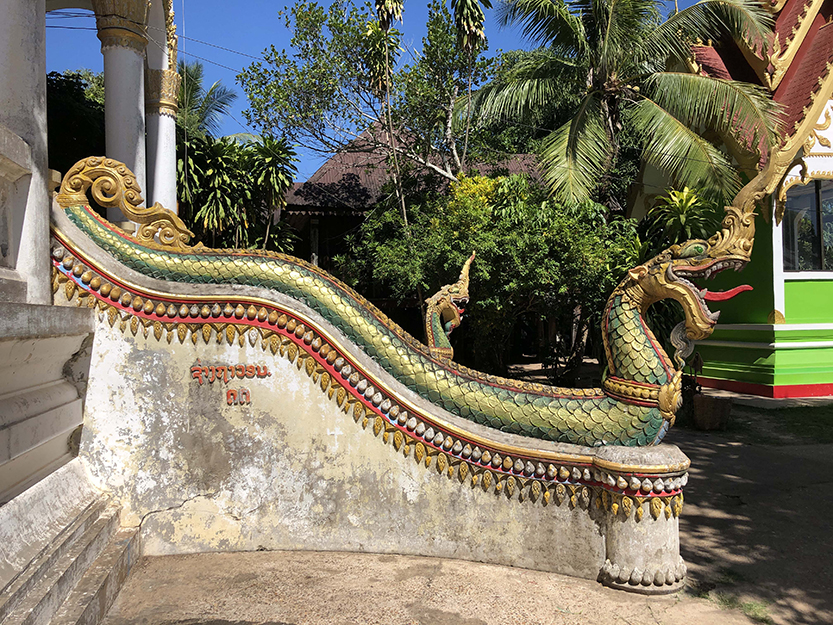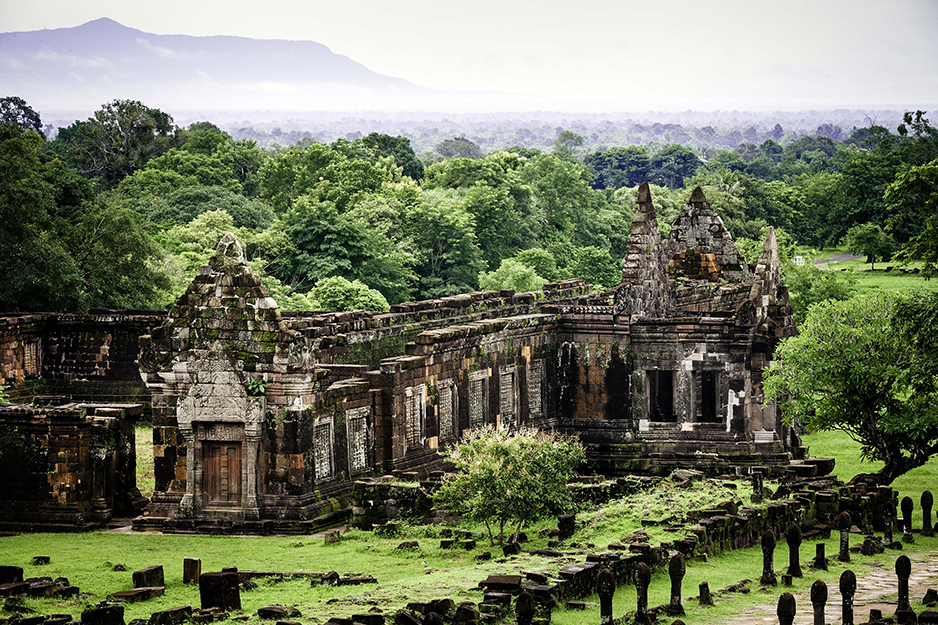Water buffalo wallow in the mud while farmers harvest sticky rice by hand, the way they have for hundreds of years. Roadside stands are laden with fresh coconuts and watermelons. Towering palms and sprawling rain trees line the Mekong River; its surface dotted with long, colorful, wooden boats. Before we’ve even reached what was once the seat of the Kingdom of Champasak my body relaxes, absorbing the super-saturated hues of the countryside.
Entering Champasak town, I eye the guesthouses and restaurants, their shady, riverside decks lush with green foliage. We set out from Wat Luang Kao, a vibrantly beautiful temple, to follow a shady dirt trail that winds its way along the river bank through a few of the 9 villages that make up Champasak today. It’s hidden from the main road and feels worlds away from modern life. Among the traditional wooden houses on stilts, we catch intimate glimpses of locals’ daily lives – a man washing his hair at an outdoor sink, a family picnicking in a bamboo grove, a man mending fishing nets. A couple on a scooter whiz by with a large Mekong river fish swinging behind them. A line is hung with strips of buffalo skin to make Lao-style jerky. Two women are splitting bamboo, and an old woman deftly weaves the strips into a basket for sticky rice. In a clearing, large translucent discs of hand-made rice noodles dry on bamboo screens in the midday sun.

We explore Wat Meuang Kang, the oldest active temple in Champasak, built in the 19th century and fusing several architectural styles, and then stop in at a nearby house to experience Lao cooking. I’m handed an apron and ushered into a traditional Lao kitchen. Our host Mik is warm and friendly and puts me to work with a large wooden mortar and pestle. I pound fiery red chilies, garlic, and tomatoes into a paste. We add strips of green papaya, fresh lime, and dark and funky fermented fish sauce, padaek, for a papaya salad. Little round eggplants, roasted until meltingly soft, are pounded with sesame seeds and dried chilies to create a baba ganoush-like dish, topped with cilantro and green onions from Mik’s kitchen garden.

I’m full but buoyed by the morning’s experiences, and I notice even the air here feels charged with a different energy. I’m not surprised that this plain between the Mekong and the mountains has been considered sacred for well over a thousand years. You can cycle along the Ancient Khmer road, originally linking India to Cambodia, and find the earthen walls of an ancient city. Dating back to the 5th century, it is believed to be the oldest urban settlement in Southeast Asia. And then there is the undeniable magic of a golden hour visit to Wat Phou.

Soulivanh Phounthareungsy fell in love with the carvings of fantastical deities adorning the temple’s tilted lintels. He taught himself to sculpt and fire clay so that he might recreate them in his Champasak Pottery studio. He is probably the only sculptor currently working in this style in Laos. His enthusiasm for Champasak, its culture, its people, and their way of life, is contagious. Before we head for dinner, we pop out back to see the large, handmade earthen kiln. Behind it rice fields and Phou Kao mountain where the sun is setting over Wat Phou. “It’s always been a special place,” he says. In the evening, Champasak is even more enchanting. The warm glow of woven lanterns illuminate tureens of Mekong fish soup perfumed with lemongrass, spicy laap, and baskets of sticky rice. The magic that compelled people to settle here a thousand years ago appears to be alive and well today.
GETTING THERE
Lao Airlines flies regularly to Pakse from Vientiane, Luang Prabang, Bangkok, and Siem Reap.
Champasak town is 40km south of Pakse.
1. Soulivanh sculpts a Khmer figurine
2. Wat Phou
3. A cheerful villager weaves bamboo
4. A colorful Naga staircase
5. Mr. Tiger guides a guest in Champasak
Experience Champasak
Book a guide for one of Wat Phou and
Champasak’s Heritage and Archaeology Trails:
Mr. Bouasone Phommaboud, Champasak Tourism Information Centre
+856 (0)30 09 23 96 73
Mr. Soubanh Kanhaphanh, Vat Phou Museum
+856 (0)20 55 76 92 21
information@vatphou-champassak.com
Book a walking tour of Champasak Village Life with Mr. Tiger: thanaphone@laogo-carrental.com
Boun Wat Phou
Wat Phou festival, one of the largest festivals in Laos, attracts thousands of people each year for 3 days and nights of celebration including prayer ceremonies, almsgiving, and traditional games, music, and dancing. This year the festival will be held on Feb 07–09.
See more at vatphou-champassak.com
Text BY Rosemary Murphy & Bounpone Vannaphone
PHOTOGRAPHS BY Swisscontact



 ລາວ
ລາວ
